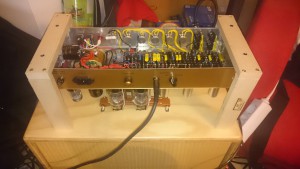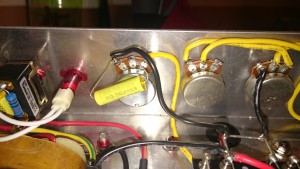Ever had the problem of your JTM-45 suddenly starting to howl? You changed all valves, suspecting it to be a case of “microphonia” and that problem is still there?
Well, that happened to me. Actually, my JTM-45 is a Cream JTA-45 from http://www.twinsound.de, a professionally built, hand-wired clone, but that doesn’t matter in that particular case. Since the amp had just been bought, I instantly contacted the maker and he would send me a couple of replacement valves to rule out a micro-phonic valve. It first appeared that the issue was gone. Until I was just in the middle of our bi-weekly jam session, hitting the first D on the A string and my amp would start to oscillate like mad. I thought, “Oh no, not again!” and then we tried to reproduce it. We even used a chop stick and tapped against the valves to hear if they’re the cause. No, they were ok. Until I accidentally hit the presence knob and it made a loud popping noise. I repeated doing that until it started howling again. What the heck? A micro-phonic presence knob? I’ve never heard of that before. 🙂
Well, back at home I wrote the amp maker about that issue, and it became clear, that I would have to send it in. It would have meant weeks without my beloved JTA. So I decided to do something, I wouldn’t really recommend anyone, who wants to keep their warranty: I opened the amp, put it into a little self-build frame and used the chop stick to tap against the back of the presence pot and the connected capacitor, while the amp was switched on. There was it again: That loud popping noise. So I measured the resistance of the pot and ordered a replacement for the both, the presence pot and the capacitor. I suspected the pot’s lug connected to GND being partly broken, as it kind of made sense to me, that GND being an “unreliable reference point” in that part of the circuit might cause the power amp to go nuts. 😉
Once I received the parts, I replaced pot and cap and gave it a loud test run. I also tapped against it and everything was eventually working as expected. To sum it up: I’ve spent EUR 2.50 and 20 minutes of work and testing to fix it, instead of having to send in the amp to a workshop, costing the amp maker probably a hundred times more money.
Nevertheless, I don’t want to encourage you to void your warranty nor to risk your life, as we’re talking about high voltage circuits! During my apprenticeship, I learned how to deal with them. I’m just posting this here, because when I was facing the issue, I had a hard time finding information from people, who might have suffered from similar problems. So I’m hoping it might be of some help. 🙂
I’m so happy about all the geek manufacturers out there, still hand-wiring amps. They are so damn service-friendly. 🙂

